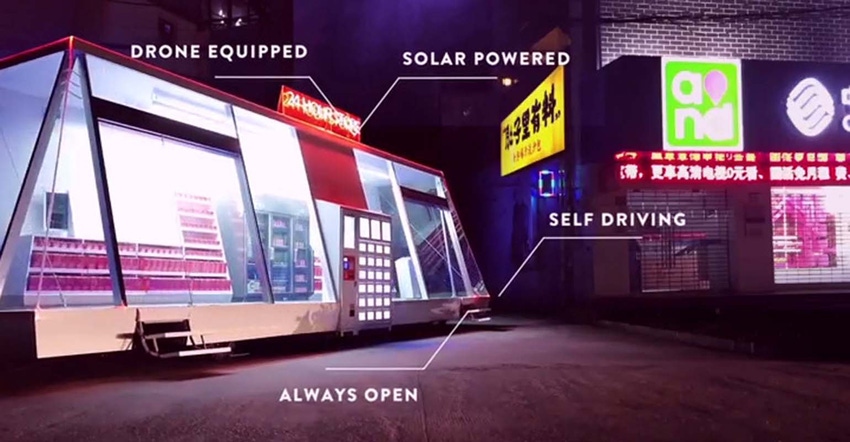
Millennials, which now make up a bigger chunk of population than aging baby boomers, think differently about food. They don’t trust big brands, they don’t like traditional grocery stores, and they want their food to have a cause behind it.
Even as these trends cause retailers to scramble, technology has come along to cause further disruption in the food business.
What does it all mean for food and the people who produce it? Here’s what we’ve learned from talking with sources.
For one, there are fewer people buying from grocery stores. Instead they are buying meal kits or buying food online, with apps like Kroger’s click and collect, or Amazon Fresh. In 2016, 28% of millennials were shopping online, compared to 16% of baby boomers. Less than 5% of groceries are purchased online, but that number is increasing rapidly. It’s expected to be 25% by 2025.
So how can grocery stores lure millennials?
“Supermarkets of the future won’t be super in size. What they will be super in is understanding the customer and meeting expectations,” says Mary Shelman, former director of the Harvard Business School’s Agribusiness program. “They’re going to have to embrace technology and data. They will be really focused on telling product stories. They will have to be able to create experiences that will keep these millennials coming back.”

“Supermarkets of the future won’t be super in size,” says Mary Shelman. “What they will be super in is understanding the customer and meeting expectations.”
AI, robots on the way
There’s no doubt artificial intelligence, the cloud and robots are disrupting traditional ways to purchase food. Ocado is a British store and the world’s largest online-only supermarket. It’s profitable. The business model is simple: we don’t have to have stores, we’ll bring everything to your house.
The company uses huge distribution centers. Robotics and artificial intelligence move products from the warehouse to a grocery bag without being touched by a human. There are four or five of these warehouses already.
In 2011 British-based Tesco, opened virtual stores called HomePlus in South Korean Subway stations. Weary commuters downloaded the HomePlus app and used smart phones to scan product QR codes. The products would be delivered home, usually the same day. The company was later sold to MBK Partners but rose to become the second largest retail store in the country.
“It’s the marriage of technology and convenience,” says Shelman.
In Shanghai, China, Himalafy is beta testing Wheely’s Moby Mart, a mobile, app-driven 24-hour online autonomous retail shop that offers products for immediate consumption, such as milk, lunch - even over the counter medicine. There are no people and no checkout lines. Just enter the store, scan what you need with your phone, and leave. The big dream is for these self-driving vehicles to be allowed to move on roads back and forth from warehouses or other shopping areas.
Amazon Go has taken a different approach. In their prototype store, set to open sometime soon in Seattle, there is no checkout line and no staff. You walk in, scan your phone to let the store know you are there, put items in a basket and walk out the door. Afterwards Amazon sends you a receipt showing the products you bought.
“They are still working out the bugs on this,” reports Shelman. The Wall Street Journal earlier this year reported that the company’s payment system was unable to handle or process payments when more than 20 people were in the store at a time. The system also struggled when an item was moved from its specific location on a shelf.
Meal kits on the rise
Meal kit delivery subscriptions are also on the rise. One in four Americans have tried it and 150 companies now work in this space. For those who try, loyalty is high – 70% of people continue to purchase once they try them. Blue Apron is the big one here, delivering 1 million meals a month; at $10 a meal that’s $1 billion worth of business.
“Interestingly, customers tell Blue April what they don’t want, and the company decides what it will send you,” says Shelman. “They look at which meals get good ratings, but also look back to see what is available on their farms each week. That’s how they optimize their business model.
“It’s convenient, but more importantly you don’t have to decide what to have each night,” she adds. “This way it shows up at your door and you don’t waste food. If the recipe calls for two stalks of celery, that’s what you get.”
Rise of the ‘grocerant’
Traditional brick and mortar stores are fighting back with a combination of grocery and restaurant – the so-called ‘grocerant.’ You’re now seeing supermarkets with big selections of prepared food inside, ranging from quick take-out to fine restaurant dining.
A chain called Eataly, started in Italy in 2007, is a re-creation of a food hall. “There’s wonderful Italian products you can buy, but there’s also a wonderful restaurant,” says Shelman. “Off to the side of the seafood area there’s a wonderful seafood restaurant. There are 31 of these around the world.
“The one in New York is mobbed all the time,” she concludes. “Everybody loves it because it’s an experience – it’s not just buying food.”
The opinions of the author are not necessarily those of Farm Futures or Farm Progress.
About the Author(s)
You May Also Like






